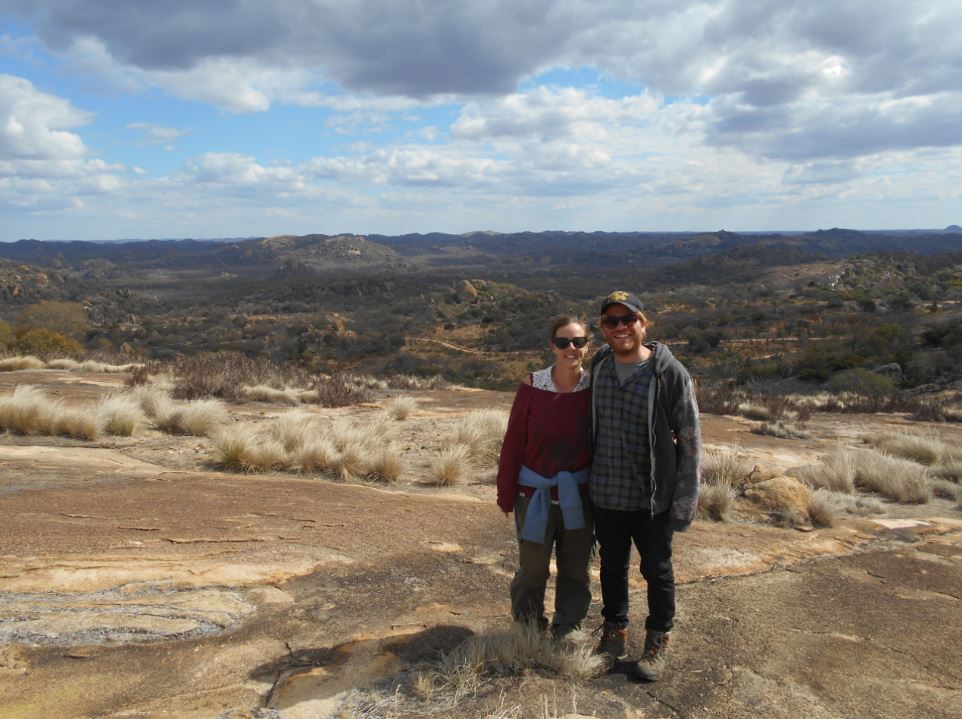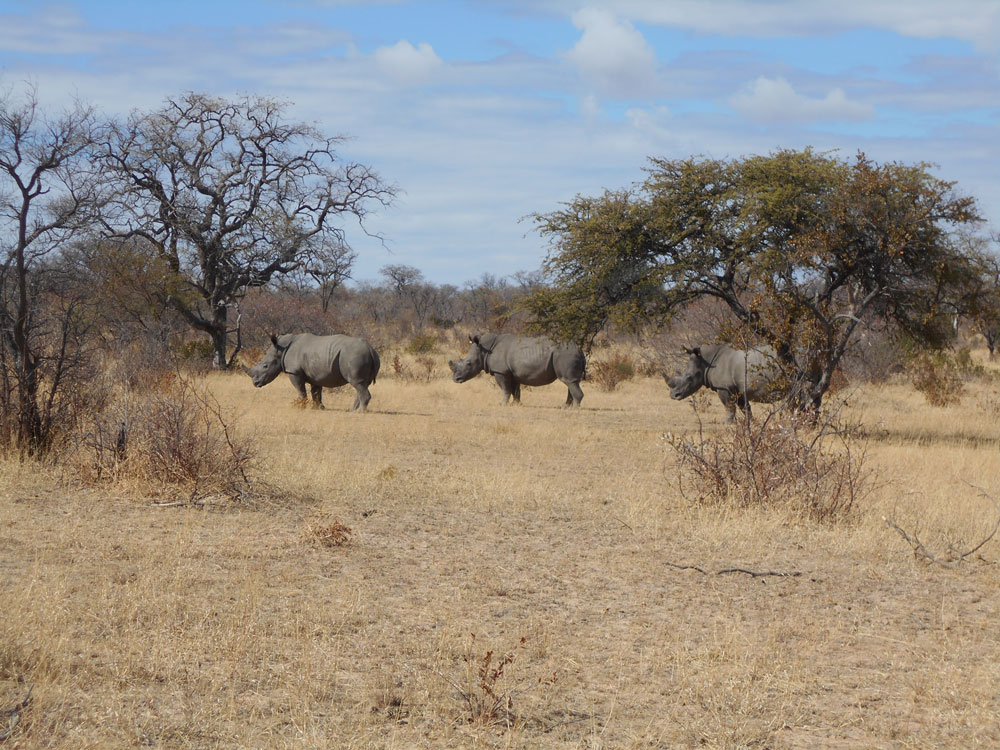Walking among the rhinos
Throughout this trip Claire and I had been lucky enough to see a real range of beautiful wildlife. We’d seen lions, leopards, hyenas, elephants, hippos, giraffes, zebras, crocodiles, a range of antelope and birds of prey and even the magnificent mountain gorillas in Uganda. However, there was one other big animal that we had yet to see: the rhino. Rhinos are, unfortunately, very rare due to the fact that they have been hunted to near extinction. Their horns are incredibly valuable, and even though it is illegal to kill these protected animals, people still do. Rather bizarrely, most of the horns are sold to China, where they are crushed up and used in a similar way to Viagra – though apparently it is not supposed to have any effect at all. But it was the rhinos that we were going to see in Matopas National Park just outside Bulawayo.
Claire and I had arrived in Bulawayo off the train the day before and spent the night in our tent at Burke’s Paradise, a nice campsite/backpackers lodge on the outskirts of town. And the next morning we were picked up by Linette our guide for the day who drove us, and three Spanish people who made up the rest of our group, into Matopos National Park. We were on the hunt for rhinos, and within half an hour Linette had received a call from the rangers in the park to say some were near. We pulled up on the side of the road where a couple of rangers with AK47s were waiting for us. We all jumped off the truck and started slowly making our way through the thick bush. The pathway was narrow and there were bushes and shrubs everywhere making it rather hard to see too far ahead. When you know that rhinos are nearby and you cannot see for more than a metre or two, it does start to get rather unnerving. You don’t want to accidentally bump into on of these animals.
After walking for around five minutes away from the road the ranger at the front of our single file line stopped. We all came to a halt and peered forward to where he was pointing and there, in the bush, relaxing, were four huge rhinos. We were on foot, a mere five or six metres away from these amazing animals, and stood there in the peace and quiet of the national park watching them relaxing for twenty minutes or so. Seeing animals in the wild, especially ones as impressive as these, is always a joy. Before we set off we were told that rhinos have very good hearing but cannot see very well. Their ears are fantastic and are constantly on the move like satellite dishes scanning the air for any sounds. We were also told that if they wag their tails they are stressed, and if they were laying down then they felt relaxed. Lucky for us these rhinos seemed pretty calm. Lynette told us, before we got close to them, that if one of them did run, we were supposed to stand still. If we move then they might see us and dart in our direction. I cannot imagine how I would have actually reacted if one of these giant ramming machines did start running in my direction. After spending twenty minutes or so in the thick bush with the rhinos we were off again, on the hunt for some more.

World’s View
The next bunch of rhinos we came across were out in the open in the dusty dry savannah. We climbed a large hill and looked out over the plains and in the distance we could just about make out these grey blobs. Joined by another ranger with another AK47, we made our way out into the park to get close to yet more rhinos. This time the terrain was barren and very flat. You could see for long distances with the views being only slightly interrupted by the odd tree or bush. This meant that we didn’t have to get too close to the rhinos and could watch them for a safer (and for the rhinos less stressful) distance. Whilst we were stood watching these animals relaxing in the mid morning sunshine we heard a rumbling and glanced to our right. Running past us, around twenty metres away, was a large herd of wildebeest. They had been startled by something and ran off into the distance. It was a real sight to behold, seeing so many of these animals running together in a group, and it conjured up images from The Lion King. Before heading back to the car to embark on the next part of our day, we came across yet more rhinos. In total that day we saw ten of these animals and we were told by lots of people that that is a lot.
Matopos National Park is full of gigantic boulders and rocks, some of which are the size of houses. The hills are dotted with these rocks, piled high as if they’d been placed there by some higher being. The skyline is therefore punctuated by these giant towers, that look as if they could tumble at any moment. We pulled up by the side of the road and Lynette pointed out one rock, roughly the size of a small British home. It was lying on the ground next to the road, which had a large crack in it. Lynette went on to explain that this area, Matopos National Park, is situated in the most spiritual region of Zimbabwe – a country full of very spiritual people. She told us that during the election a few years ago, this rock had fallen off the mountain and landed on the road, breaking a large hole in it. Apparently, this one large rock falling off this one mountain, sent the whole of Zimbabwe into a spiral of worry. The spirits weren’t happy with something and according to Lynette it became big news all over the country, not helped by the fact that the boulder had fallen during the build up to the election.
The next spot we visited was called World’s View and was named by colonialist Cecil Rhodes, after whom Rhodesia was named. Rhodes was a colonialist and diamond miner who spent a lot of his time in South Africa. He was, at one point, one of – if not the – richest men in the world. It was Rhodes (or rather men he sent in his place) who ventured north from South Africa with a handful of treaties aiming to add Mashonaland and Matabeleland (now Zimbabwe) to the British Empire. During this period, in the late 1880s and early 1890s, Britain and its people weren’t too keen on the idea of spending yet more money to extend the empire. However, Rhodes was so rich and so keen on the idea that he proposed funding the mission entirely himself. He used his money and trickery in order to con native chiefs – mainly King Lobengula who ruled much of the region – into signing treaties that essentially handed over their land to Rhodes and the British. Rhodes may have been duplicitous and willing to use lies to gain land and other resources, but he wasn’t lying about one thing – the aptly named World’s View was a place of sheer unadulterated beauty. We could see for miles as the mountains and greenish yellow scrub stretched out below. The views were out of this world and were some of the best we’d seen since landing in Africa six months previous. After spending some time soaking in the sights, we then made our way over to Cecil Rhodes’ grave after stopping to look at a large monument placed on the top of a hill to pay homage to the brave men who colonised this part of the world.

Cave paintings
After making our way down from the viewing point and eating a wonderful lunch in the midday sunshine, we were off again to take a look at these caves. After driving through some more stunning scenery and across a man made dam, we were at the bottom of the climb. At the top stood the cave and its famous paintings. These deep red paintings were scratched onto the wall and depicted people, giraffes, leopards, and other wildlife. The people in the paintings had huge buttocks, which apparently is a feature of the San people, who painted them. Apparently the San people were very short and are almost entirely gone from the world. There were groups of them in Zimbabwe and other southern African countries, however, attempts by groups to integrate them into the modern world led to many dying from illnesses that they’d never been exposed to before. According to Lynette there is now only one group left in Namibia in the desert, and they are now left alone for their own safety. Lynette told us that whilst people aren’t sure of the exact age of these paintings, they were suspected to be somewhere between seven and ten thousand years old. It really was quiet incredible being so close to something that was so very old and as the sun was slowly setting turning the sky pink, we were sure that it was the perfect end to the day.








Comments are closed here.